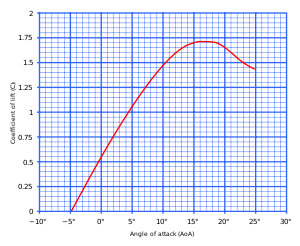Zero-lift axis

A typical lift coefficient curve.
A cambered aerofoil generates no lift when it is moving parallel to an axis called the zero-lift axis (or the zero-lift line.) When the angle of attack on an aerofoil is measured relative to the zero-lift axis it is true to say the lift coefficient is zero when the angle of attack is zero.[1] For this reason, on a cambered aerofoil the zero-lift line is better than the chord line when describing the angle of attack.[2]
When symmetric aerofoils are moving parallel to the chord line of the aerofoil, zero lift is generated. However, when cambered aerofoils are moving parallel to the chord line, lift is generated. (See diagram at right.) For symmetric aerofoils, the chord line and the zero lift line are the same.[3]
See also
References
- Anderson, John D. Jr (2005), Introduction to Flight, Section 7.4 (fifth edition), McGraw-Hill ISBN 0-07-282569-3
- Clancy, L.J. (1975), Aerodynamics, Sections 5.6 and 5.7, Pitman Publishing, London. ISBN 0-273-01120-0
- Kermode, A.C. (1972), Mechanics of Flight, Chapter 3, (p. 76, eighth edition), Pitman Publishing ISBN 0-273-31623-0
Notes
- ↑ Anderson, John D. Jr, Introduction to Flight, Section7.4 (fifth edition)
- ↑ Such a line is called the line of zero lift or neutral-lift line, and would in some senses be a better definition of the chord line, but it can only be found by wind tunnel experiments for each aerofoil, and, even when it has been found, it is awkward from the point of view of practical measurements.
Kermode, A.C., Mechanics of Flight, (p.76, eighth edition) - ↑ Clancy, L.J., Aerodynamics, paragraph 5.7(a)
This article is issued from Wikipedia - version of the 3/19/2016. The text is available under the Creative Commons Attribution/Share Alike but additional terms may apply for the media files.